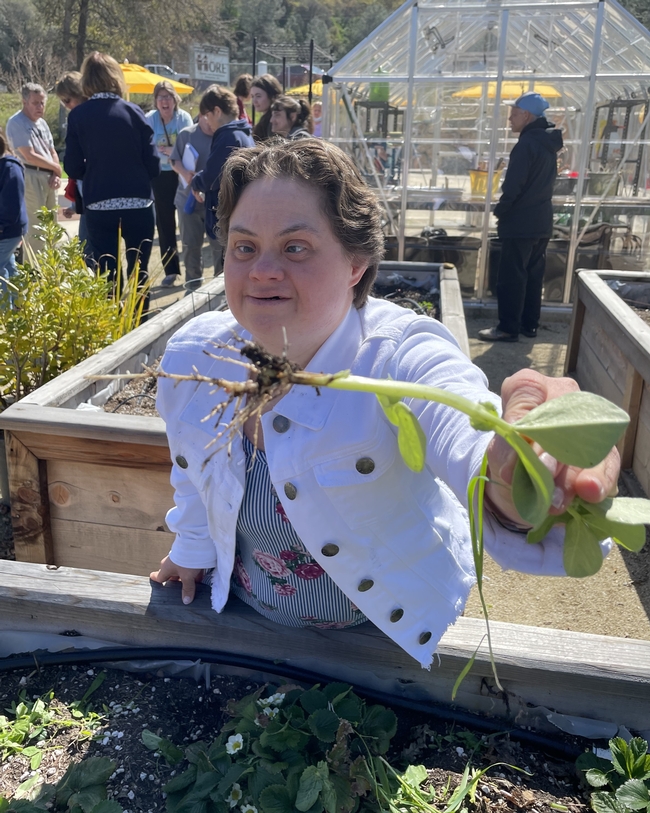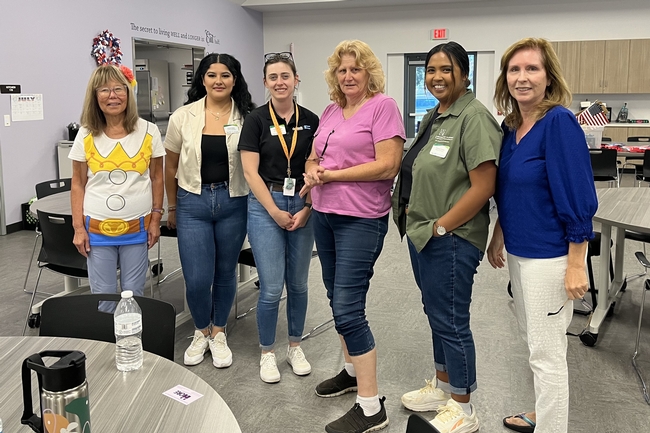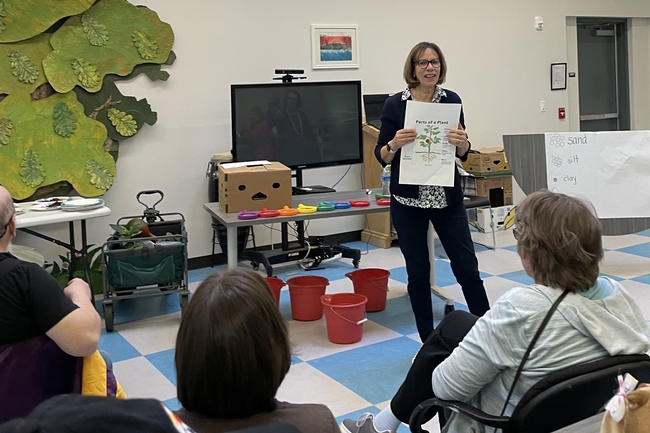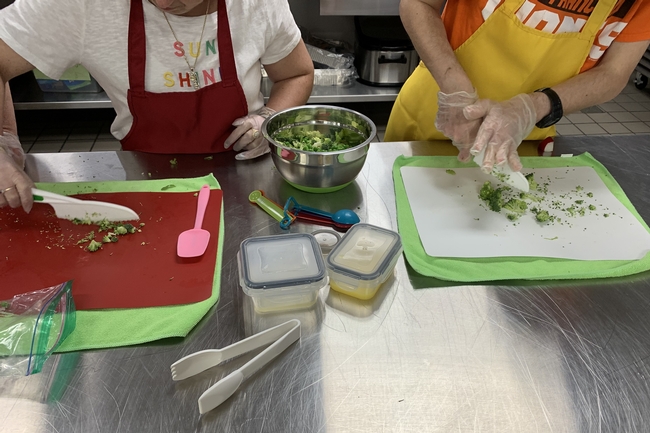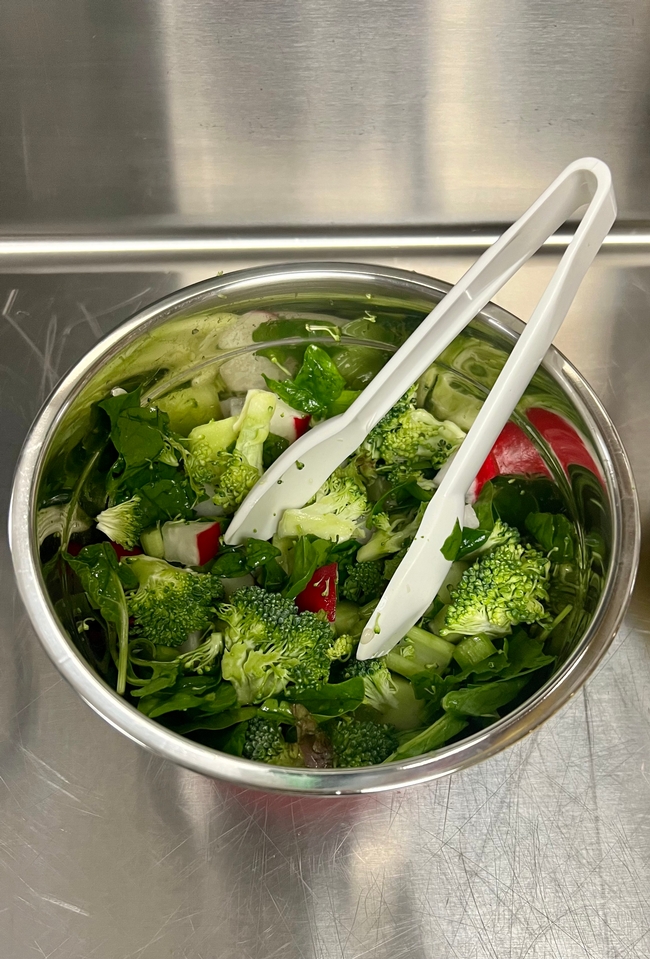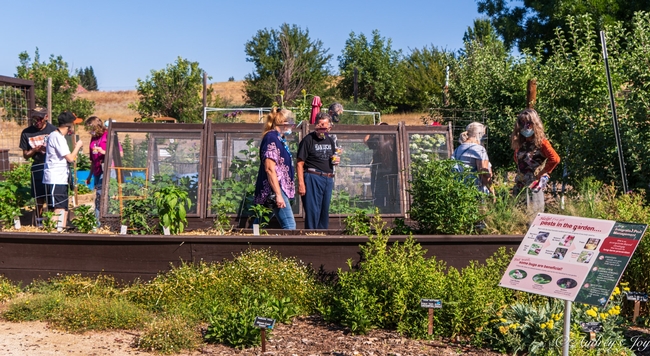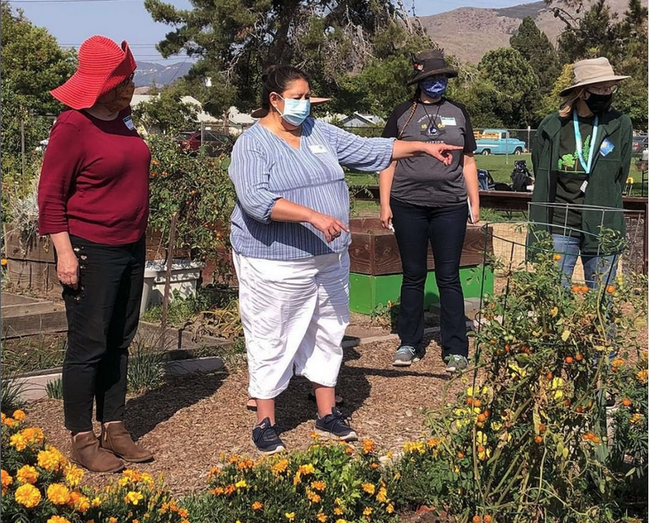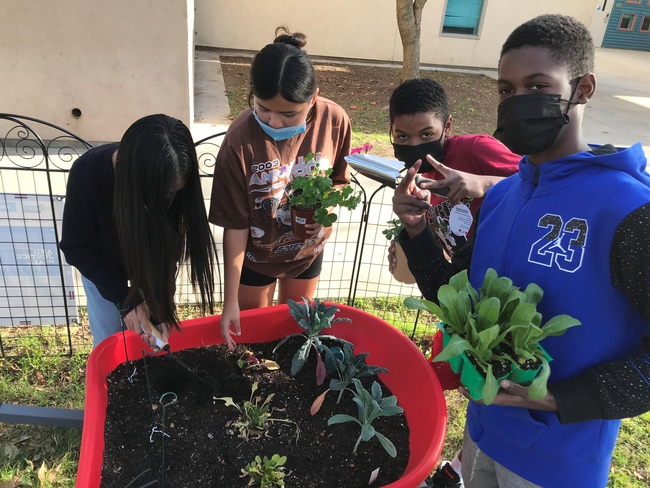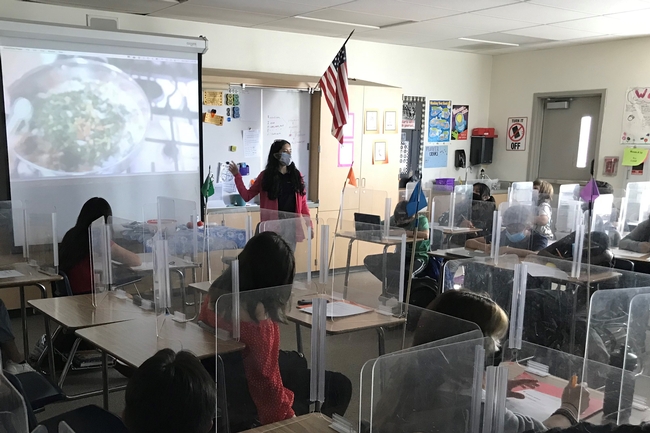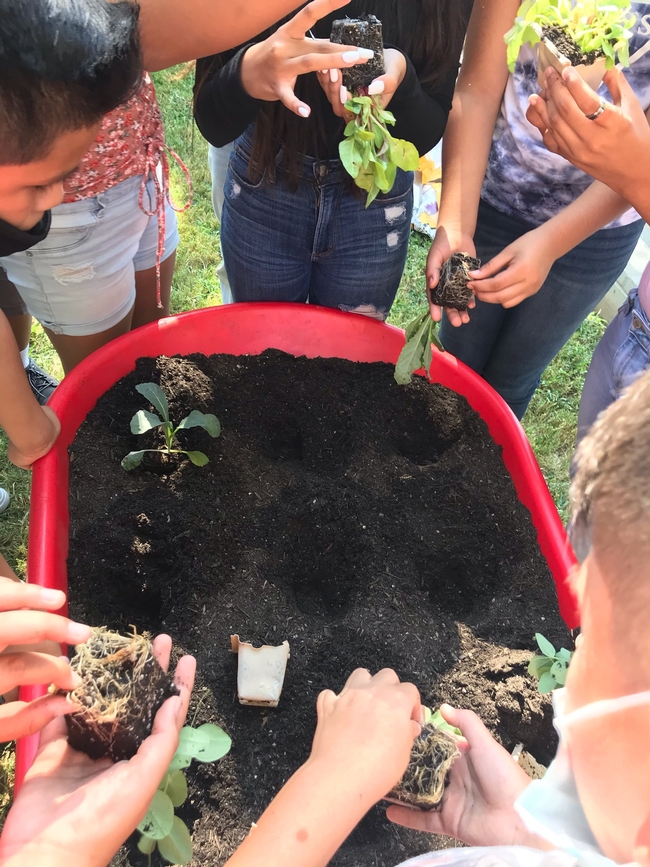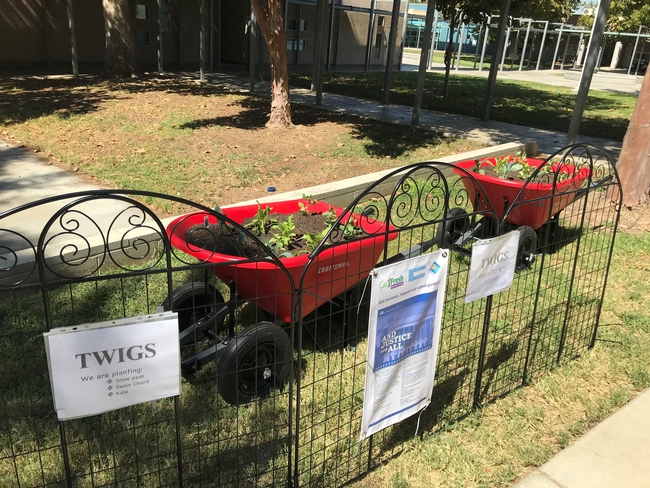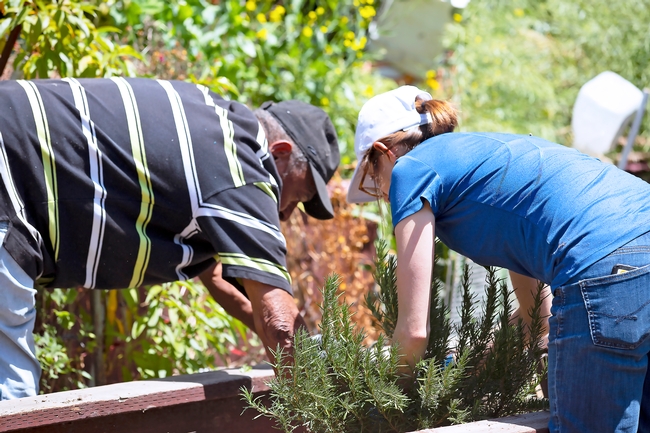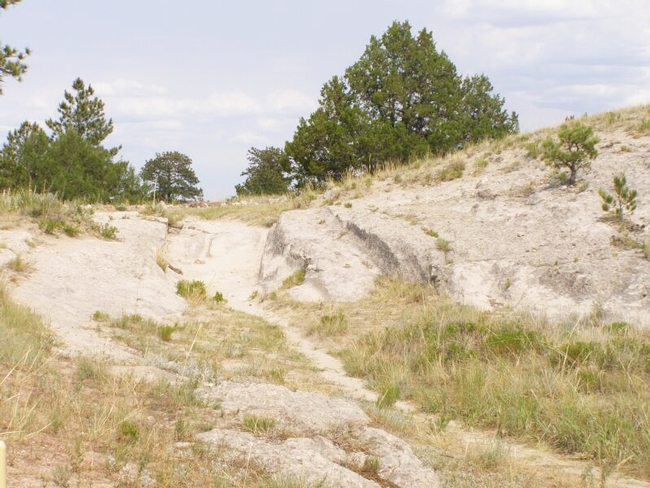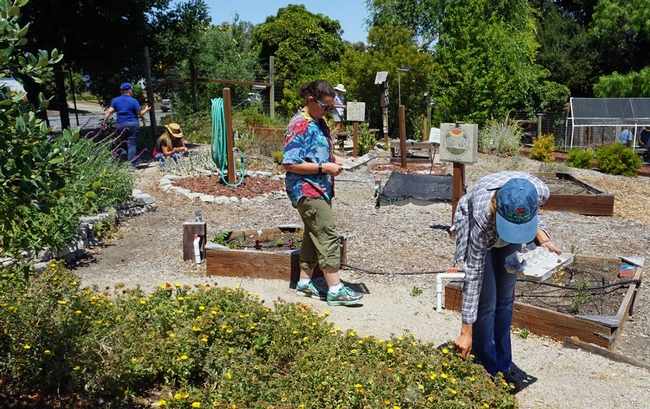Posts Tagged: gardening
Adults with disabilities learn nutrition, grow gardening and cooking skills
CalFresh Healthy Living, UC and UC Master Gardeners partner with nonprofit MORE in El Dorado County
A nonprofit serving adults with intellectual and developmental disabilities in El Dorado County, MORE has found kindred spirits in helping their clients live fuller and healthier lives – the staff and volunteers of University of California Master Gardeners and CalFresh Healthy Living, UC.
Since 2018, these programs – both affiliated with UC Agriculture and Natural Resources – have helped enrich the lives of about 60 clients at MORE, which offers services ranging from independent-living skills development to job training and placement.
“This is exactly the kind of partnership that we like to make with the community,” said MORE CEO Susie Davies, who has been with the Placerville-based organization for 40 years. “This has just been incredible; our people have learned above and beyond what we could even have imagined in nutrition and gardening.”
The three-party partnership, which Davies calls a “win-win-win,” offers a course that combines gardening and nutrition lessons, as well as a new cooking and food safety-focused class developed by educator Cailin McLaughlin in collaboration with MORE staff.
During one session, MORE clients enjoyed preparing a “plant part salad,” following a botanical lesson on the edible components of plants – fruits, roots, leaves, seeds and stems. “It was fun to cut the celery and broccoli,” said Jared (first names are used to protect privacy). “I like pouring the sauce in.”
“I liked everything about creating the salad,” said Deanne, another participant.
“MORE is the dream site, the best you could ever hope to go to, with the programming and the clients always being lovely and really just being down for anything,” said McLaughlin, a CalFresh Healthy Living nutrition educator at the Central Sierra UC Cooperative Extension office. “It's just a really cool place to be.”
CalFresh Healthy Living, UC is one of the organizations in California that teaches nutrition to people eligible for SNAP (Supplemental Nutrition Assistance Program). UC Davis administers the SNAP-Ed grant and UC Cooperative Extension educators deliver the lessons throughout the state.
‘Part of our MORE family'
Through the gardening and nutrition program, clients learn and apply their skills in the garden and greenhouse at the MORE facility and in the nearby Sherwood Demonstration Garden maintained by UC Master Gardeners of El Dorado County.
“The participants get a chance to harvest, plant, pull weeds and learn about integrated pest management, both in the vegetable garden and in the orchard,” said Tracy Celio, the local UC Master Gardeners program manager who worked with former CalFresh Healthy Living, UCCE educator Miranda Capriotti to develop the program.
“It's a very good program,” said Tony, a MORE client. “I can learn things.”
While experiencing the pride in bringing fresh produce to their home or to the MORE kitchen for use in the meal service, the clients are also taking away nutritious and healthy recipes. Jordan Postlewait, director of community access programs at MORE, said participants now know how to use ingredients from the garden to create dishes such as tomato salsa and fruit salad.
“They've taken the recipes that Cailin has given them and they go home and serve their whole group home what we had made for a snack,” Postlewait said. “They are paying attention to what they're eating.”
As a result of this awareness and knowledge of nutritious foods, Davies said that MORE clients are healthier, more energized and alert, and ready to learn. She is quick to credit the expertise and enthusiasm of McLaughlin, CalFresh Healthy Living, UCCE program coordinator Mariana Garcia, and the UC Master Gardeners staff and volunteers.
“They have the same dedication and commitment to excellence in their preparation for every session as our staff,” Davies said. “They just became part of our MORE family.”
“I like seeing Cailin and Tracy and all the staff who are my friends,” said Kenion, a MORE client.
Cooking lessons create possibilities for kitchen time, jobs
In April, two groups, each composed of six people, began participating in a new five-session course combining nutrition, food safety and basic cooking techniques. Each two-hour session included a nutrition lesson, a physical activity and time in MORE's commercial kitchen.
“It was fun getting in the kitchen and learning how to prepare my own meals,” Jared said. “I learned how to safely use a small skillet.”
Another participant, Kyle, said he uses the recipes to cook for his roommates. “I liked learning new cooking skills and recipes,” he said.
McLaughlin adapted a youth-oriented healthy eating curriculum, approved for use by CalFresh Healthy Living, UC, and tailored it for adults at MORE.
“The whole goal is to get them closer to an independent living circumstance, where either they can live in a group facility or have their own apartment – and knowing how to cook and identify healthy recipes is a huge component of that,” McLaughlin explained.
The guided kitchen experiences – and equipment like plastic safety knives – not only benefit the participants but also give their family members reassurance and confidence to include them in meal preparation.
“We've actually been asked by staff at MORE, and also by clients' parents, where we got the knives, because they would like to have their family member in the kitchen with them, if they can do it safely,” McLaughlin said. “They didn't know things like safety knives existed; they didn't know you could adapt a silicone food guard to keep them from burning themselves on a burner.”
In addition to enhancing the clients' family time, the cooking lessons could also set them up for future employment. Davies said she is in talks with a local chef about establishing a culinary training for the clients.
“This cooking program could be a preparation program for them to be involved in the culinary training program,” she said. “That's what we're really excited about.”
McLaughlin added that, for future sessions of the cooking and food-safety series, past participants have expressed interest in serving as kitchen aides and mentors.
Partners nurture clients' relationships with nature, community
Empowering clients with new skills and fostering a sense of ownership of the garden are both cornerstones of the partnership programs. Beginning in 2019, participants from MORE each adopted a tree in the Sherwood Demonstration Garden orchard to monitor and nurture.
“Almost every time they come to the garden, we check those fruit trees,” Celio said. “The trees are doing so many things throughout the year, so they're following the cycle: they watch the leaves drop; they watch the fruit come in; they see what a freeze does to their tree; they see what pests do to their tree.”
The participants experience the challenges of gardening – from managing rabbits and squirrels to coping with the loss of a pear tree due to disease – as well as its many joys.
“I liked seeing the butterflies and different plants; the butterflies drink from the bushes,” said Jen, a MORE client. “My favorite thing is the rose garden.”
At the same time, the clients have built strong relationships with the core group of UC Master Gardener volunteers and the dozen or so “vegetable garden crew” volunteers. Celio stressed that the garden programs, which were recently recognized by the statewide UC Master Gardeners program with a Search for Excellence Award, are truly collaborative.
MORE participants often bring their own ideas; one man, for example, became interested in composting and worked with MORE staff to establish a worm bin at the MORE facility garden.
“Every time I see that client, he will tell me how the worms were doing and he'll tell me how healthy the plants are that are growing next to the worm bin,” Celio said, adding that he also worked at a table during a MORE fair, teaching other clients and their family members about vermiculture.
Advocating for the greater good of the community is central to another CalFresh Healthy Living, UC collaborative project at MORE, in partnership with Stanford University's Our Voice initiative. Using an online tool and app, 12 clients have been taking photos and sharing feedback on their health and wellness experience at MORE, specifically about their walking trail. With that information, they are building a case to make the path safer and more enjoyable.
Responding to their feedback, along with the other partnership programs that are building vital skills and community, demonstrate to MORE's clients that they are appreciated and respected.
“The request from the people that we serve is that they want to be seen, they want to be heard, and they want to be valued by other community members,” Davies said. “And this is really showing them that they are valued and being seen and heard.”
For stress relief, food access, people turned to gardening during pandemic
More green spaces and urban farming opportunities could be helpful in future disasters
People who turned to gardening during the COVID-19 pandemic did so to relieve stress, connect with others and grow their own food in hopes of avoiding the virus, according to a survey conducted by researchers at the University of California, Davis, UC Agriculture and Natural Resources and international partners.
The survey report, “Gardening during COVID-19: experiences from gardeners around the world,” highlights the positive role gardening plays in mental and physical health, said Alessandro Ossola, an assistant professor of plant sciences.
“Connection to nature, relaxation and stress relief were by far the biggest reasons gardeners cited,” Ossola said.
The researchers sent links to online surveys via targeted emails to gardening groups, in newsletters and on social media between June and August 2020. They were hoping to gauge the significance of gardening as a way to cope with risk, how the pandemic changed gardening and what barriers existed.
More than 3,700 surveys were returned by gardeners from Australia, Germany and the United States.
Isolation, depression, anxiety reported
More than half of those responding said they felt isolated, anxious and depressed during the early days of the pandemic and 81% had concerns about food access. During this time, people also had more time to garden, and they saw the activity as a safe haven and a way to connect socially with others.
“Not only did gardeners describe a sense of control and security that came from food production, but they also expressed heightened experiences of joy, beauty and freedom in garden spaces,” said the report, which broke up responses by region or states.
In California, for instance, 33% of gardeners said their plots generated about 25% of their produce needs. Some gardeners with access to large spots to garden also grew food for their community.
Gardening offered a way to socialize safely during the pandemic
“People found new connections in the garden,” said Lucy Diekmann, a UC Cooperative Extension urban agriculture and food systems advisor who helped write the report. “It became a shared hobby as opposed to an individual one.”
Responses were fairly similar across all locations, even though the surveys hit in the summer and winter depending on location. “We see remarkable similarities in terms of what people are saying and the way they are interacting with their gardens,”Diekmann said.
More green opportunities needed
Many respondents also found it hard to find and buy seeds or plants and locate a spot to grow.
The report findings suggest an opportunity for government, community groups, businesses and others to promote community health by providing green spaces.
Gardening should be thought of as a public health need, one that could serve communities well in future pandemics or disasters. New Zealand, Canada and some countries in Europe write green prescriptions for people to garden to improve health.
“We need to change the narrative of how urban gardening is framed and elevate it to a key strategy for both environmental and public health,” Ossola said.
UC Davis graduate student Summer Cortez assisted with the research, as did Monika Egerer at the Technical University of Munich in Germany and experts from these Australian-based entities: Brenda Lin at Commonwealth Science and Industrial Research Organization, Jonathan Kingsley at Swinburne University of Technology and Pauline Marsh at University of Tasmania.
Sixth graders nurture wheelbarrow garden, grow community connections
After harvesting and cooking their produce, students ask for seconds of kale
How do you get notoriously finicky sixth graders to eat their leafy greens? Have them grow the vegetables themselves.
Students in Riverside have that unique opportunity through a hands-on gardening and nutrition class at Ysmael Villegas Middle School, with help from CalFresh Healthy Living, University of California Cooperative Extension Riverside County (a part of UC Agriculture and Natural Resources).
“We have middle schoolers asking for seconds and thirds of kale – that's not something that's typical!” said Claudia Carlos, program supervisor for CalFresh Healthy Living, UCCE Riverside, which implements SNAP-Ed locally (the educational arm of the Supplemental Nutrition Assistance Program, formerly known as food stamps).
Growing and tending kale, mint and snap peas in two wheelbarrow gardens on the Villegas campus, the second cohort of students capped their 12-week class with a cooking lesson. A simple recipe combining their kale with tomatoes, onions and coconut milk was a big hit.
“It's one thing to tell youth they should eat healthy, but not until they actually grow the food do they actually take a lot of pride in that food they've grown and harvested,” Carlos explained.
By the end of this school year, about 75 students (in three cohorts) will have taken the class, during which they explore career pathways in gardening, agriculture and nutrition – while cultivating new skills and healthy habits such as choosing nutritious snacks and incorporating exercise into their day. Techniques developed by the UC help encourage effective behavior change.
“In this exploratory class, I've learned how to plant, and take care of plants,” wrote one student, in evaluating the class. “I can use these skills later on in life most likely, and I also learned how to be more healthy.”
Teachers observed that other students also have taken steps to apply their new skills and knowledge.
“They become more confident in themselves and their abilities to make healthy choices for themselves and their families – and to advocate for their parents to buy that kale and actually eat it,” said Daisy Valdez, community education specialist for CalFresh Healthy Living, UCCE Riverside, who is helping teach the class.
Valdez also has been training Villegas teacher Kim Weiss, so that Weiss – a first-year full-time teacher – is empowered to teach future cohorts. Both Valdez and Weiss noticed that nearly all of the youth have been enthusiastic about getting their hands in the soil, watering and weeding regularly – even taking care of the “worm hotel.”
“Students are very invested in the plants, how they are doing and their well-being,” Weiss said. “They ask if they can come back to the class and help care for the plants and worms; students worry about who will take care of the plants and worms after they leave.”
In addition to basic gardening and cooking skills, the class also incorporates lessons about herbs and spices, beneficial insects and pollinators, and cultural dimensions of food. The kale cooking lesson, which recently took place during Black History Month, presented a chance to teach about African food and culinary traditions.
“It allows them to not just connect to the garden but also to connect to their peers and to connect to the world around them,” said Valdez, who added that the garden, planted in a pair of cheerful red wheelbarrows, also beautifies the campus and sparks conversations among their schoolmates about food systems.
The Villegas partnership with CalFresh Healthy Living, UCCE Riverside also benefits the entire school in other ways, with programs reaching hundreds of students and community members. In spring 2021, under Valdez's supervision, students created a “food access board” that shows how to obtain healthy and affordable food through CalFresh EBT, farmers markets, WIC and other resources.
The board, which has been set up in the library, cafeteria and lobby, is seen and used by students and family members. Valdez also engaged parents and the broader community by hosting gardening and nutrition workshops.
This year, Villegas students will have the opportunity to further deepen their cultural connections through a new Youth Participatory Action Research project, in which they explore their personal and family histories through the lens of a meaningful and healthy food item, practice or tradition. Youth will then share their findings with school peers and administrators.
As Carlos noted, these young people will not forget such engaging and immersive experiences with food any time soon. In their evaluations, many students wrote that they learned valuable lessons about compost, care for plants and insects, and healthy eating.
And, as one sixth grader said: “I also learned that kale and coconut milk is amazing!”
Adjusting soil pH in California gardens
Soil acidity is an important factor for gardeners to consider when placing ornamental and edible plants in landscapes and vegetable gardens. It is possible to add amendments to the soil to adjust pH, but according to Dustin Blakey, UC Cooperative Extension advisor in Inyo and Mono counties, it's not always the best course of action.
“It is generally best to work with the soil you have, rather than try to attain the soil you wish for,” Blakey said.
Blakey wrote a six-page publication, “Adjusting Soil pH in California Gardens,” which is available for free download from the UC Agriculture and Natural Resources catalog.
In the new publication, Blakey describes how to quantify acidity, measure soil Ph, increase acidity and reduce acidity. Readers will also find typical desirable soil pH range for select garden plants, including fruit, nut and citrus trees, blueberries, avocados, azaleas, vegetables and lawns.
Download the full publication here: https://anrcatalog.ucanr.edu/Details.aspx?itemNo=8710.
Home gardening is more pleasant and successful with healthy soil
With winter soon upon us, it's a good time to treat your garden bed just like the one where you tuck in at night, says Dustin Blakey, UC Cooperative Extension advisor, director and UC Master Gardener coordinator in Inyo and Mono counties.
Blakey hosted a webinar on Facebook during Healthy Soils Week 2020 (Nov. 30 – Dec. 5) to advise home gardeners how to promote healthy soils to maximize their gardening success.
“Some genius suggested we call garden plots ‘beds,'” he said. “It makes sense. Mom was right. Don't stand or walk on the bed. Keep it neat and tidy. And cover it, in the case of a garden bed, with organic mulch.”
The goal is to end up with garden soil that holds adequate water, nutrients and air, supports soil life forms, like worms, insects and microorganisms, and is convenient to work with.
“If I have to get a mallet to bang a trowel into the ground, it's not healthy soil,” Blakey said.
As a first step, designate permanent walkways in the garden so only those areas become compacted by foot traffic, leaving the plots where vegetables will be grown undisturbed.
“Along parts of the Oregon Trail, almost 200 years later you can still see the ruts where the wagon wheels rolled, and plants aren't growing there,” Blakey said.
He recommended gardeners cover their walkways with gravel, decomposed granite or organic materials like wood chips, bark or grass. Installing raised garden beds is an ideal way to differentiate growing and walking areas. In his own garden, Blakey built the beds four feet wide to have easy access to all the plants while standing on the walkways.
Add compost to the soil inside the beds to reap a variety of benefits.
“It's often said, no matter the problem, compost is the solution,” Blakey said.
Compost provides a food source for beneficial microorganisms in the soil. If soil is sandy, compost helps it hold water and nutrients. If the soil is clay-like, compost loosens the soil, making it more friable.
Covering the garden soil surface with mulch or cover crops is also critical to soil health, Blakey said. The topping moderates the soil temperature, supporting the organisms living below ground. The covering helps prevent weeds, and as the mulch breaks down, it adds organic matter to the soil.
“You can also grow cover crops,” Blakey said. “I'm surprised how few gardeners use cover crops. Put some seeds in the ground instead of buying a bag of amendments.”
Cover crops can be part of a healthy garden crop rotation, keeping roots growing in the soil all year long.
“Grasses scavenge nutrients. Legumes fix nitrogen. I grow sweet potatoes. They shade everything and keep the weeds at bay. A daikon radish cover crop penetrates deep into the ground, naturally tilling the soil,” he said.
Blakey discourages a common habit of some long-time gardeners, frequent rototilling with a heavy machine, and rather encourages what he calls “gentle tilling.”
“You don't need power equipment. Experiment with using a shovel,” he said. “My soil is loose and easy to work. Some beds, I don't even turn. I just plant directly in the healthy soil.”
View a recording of Blakey's one-hour webinar on healthy soil on the UC Master Gardener Program Facebook page: https://www.facebook.com/UCMasterGardeners. The UC Master Gardeners offer many online gardening resources and programs in most California counties. Find your local program at http://mg.ucanr.edu/FindUs.

